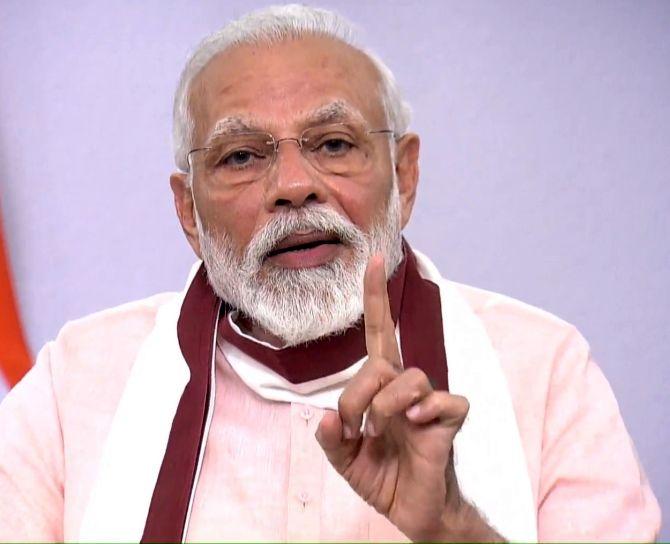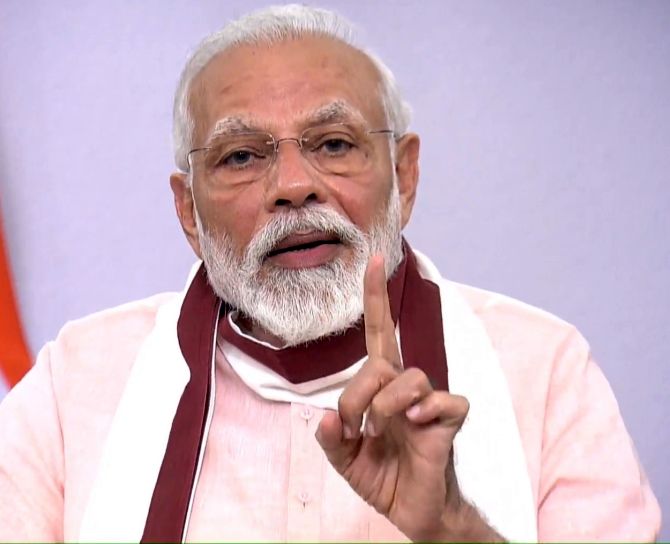There were clear indications of extension of the COVID-19-induced lockdown with Prime Minister Narendra Modi on Tuesday saying that “lockdown-4” will have completely different contours and rules.

On the basis of recommendations received from states, new rules will be framed, and information about it will be conveyed before May 18, Modi said in his address to the nation.
The prime minister said the fourth phase of the lockdown, which he described as “lockdown-4”, will have completely different contours and will have a new set of rules.
In a video conference with chief ministers on Monday, Modi had said he is of the “firm view that the measures needed in the first phase of lockdown were not needed during the second phase and similarly, measures needed in the third phase are not needed in the fourth.”
The country has been under lockdown since March 25 and the third phase ends on May 17.
Modi during his address to the nation noted that several experts and scientists have said that the novel coronavirus is going to be part of our lives for a “long time”.
“But, it is also important to ensure that our life does not revolve only around it (novel coronavirus),” he said.
He urged people to work towards their targets while taking precautions like wearing masks and maintaining do gaz doori (two yards of separation).
In his virtual meet with chief ministers, Modi had also said the challenges are two-fold — reduction of transmission rate of the novel coronavirus and gradual increase in public activities while adhering to all guidelines.
The Centre and states will have to work towards achieving the twin objectives, he had said.
Prime Minister Narendra Modi announced a Rs 20 lakh crore economic package to help individuals and businesses deal with the Covid-19 pandemic and the lockdown enforced to combat its spread, and to, as he put it, turn the “crisis into an opportunity”.
Details of the package, which is the equivalent of a little below 10% of the GDP, will be announced over the next few days, starting Wednesday, by finance minister Nirmala Sitharaman. The Prime Minister said the package – Atmanirbhar Bharat Abhiyan (Self-reliant India Mission) — would cover “land, labour, liquidity, and laws”, industry and businesses of all sizes, and farmers, entrepreneurs, and the middle class. And he repeatedly stressed on the theme of self-reliance and the importance of keeping manufacturing, markets and supply chains local.
“When India speaks of self-reliance, it does not advocate a self-centered system. In India’s self-reliance there is a concern for the whole world’s happiness, cooperation and peace,” Modi said, adding that local suppliers have met India’s demands in this hour of crisis, and now “Indians have to be ‘vocal about local’ and buy products from them”.
The amount includes the ~1.7 lakh crore already announced — a cash transfer and food package aimed at the most vulnerable — and the measures announced by the Reserve Bank of India (RBI). The central bank has announced liquidity infusion and targeted credit measures aggregating anything between ~4.5 lakh crore. That means the package to be announced over the next few days will total around ~14 lakh crore.
While the specifics of the package will emerge over the next few days, a spate of reports over the past few weeks have indicated the kind of initiatives that may be launched: a large fund for micro, small, and medium enterprises (MSMEs); a well-capitalised bad bank; a loan guarantee scheme for businesses; incentives for local manufacturing; and direct cash transfers to the poor.
The ~20 lakh crore package meets the demand of industry bodies — the Confederation of Indian Industry (CII) asked for an “immediate stimulus package” of ~15 lakh crore on May 9; the Federation of Indian Chambers of Commerce and Industry (Ficci) asked for ~10 lakh crore; and the PHD Chamber of Commerce ~16 lakh crore.
The package, as a proportion of GDP, also compares favourably with the packages announced by other G20 nations. Japan is an outlier with a package that is estimated to be worth around 20% of its GDP but the US and Australia have announced packages estimated at close to 10% of their respective GDPs, and Canada 8.4%. China’s stimulus is estimated at around 2.5% of its GDP.
The stimulus comes against the backdrop of predictions that the Indian economy will contract this year — securities firm Nomura believes that it will by almost as much as 5.2% — and a record decline of 16.7% in factory output in March, when less than 10 days were affected by the nationwide lockdown.
Modi said that the virus, while ravaging the world, has also provided an opportunity to strengthen India’s resolve and not waver from its goals. “We are standing at a crucial juncture. This crisis has a message for us. It has provided us an opportunity… we have to protect ourselves and move ahead as well,” Modi said.
The mention of land, labour, and laws by the PM presages significant reforms that could make it easier to do business. Already, Madhya Pradesh and Uttar Pradesh have suspended most labour laws (the former for both existing and new factories and the latter only for new ones) as part of an effort to boost the economy, attract investment, and find jobs for tens of millions of migrant labourers who have fled back home to some of the country’s least developed and industrialised states.
A boost in local industrial and manufacturing activity also fits in well with Modi’s theme of a self-reliant India. “The only way ahead is to be self-reliant,” he said. At least some of his meetings over the past month-and-half have looked at ways to boost local manufacturing.
In the speech, the Prime Minister spoke of the five pillars of a self-reliant India: an economy that doesn’t grow incrementally but makes quantum jumps; infrastructure development; a technology-driven system; a vibrant demographic mix; and better supply chains to spur demand.
The Union Cabinet is set to approve the package on Wednesday morning.
Several economists welcomed the package as “substantial” but said they would prefer to see the fine print and disaggregated allocations to gauge the full extent of the impact.
“It’s welcome despite the government appearing initially to be hesitant. It has yielded to demands of so many economists and industry alike. The only way to go is to revise the fiscal policy (i.e. loosening government spending) so that economic growth can spring back,” said NR Bhanumurthy of the National Institute of Public Finance and Policy.
“The biggest takeaway is the PM’s emphasis on self-reliance. This is a major change in India’s economic policy as we were earlier looking at globalisation. And if this self-reliance is boosted by India’s MSME sector, then we are looking at countering China by its own model. ~20 lakh crore is not a small amount; we need to know where the money will come and how it will be it is a redistributed,” said Abhirup Sarkar, an economist with Indian Statistical Institute.
But Vivek Dehejia, a professor at Carlton University, was more sceptical. “The speech was skimpy on bold reforms and there was more discussion of the local, self reliance and Make in India (read import substitution). Colour me sceptical at this point,” he tweeted.
The Opposition Congress party said that the PM should have shown greater empathy by addressing the plight of thousands of migrants displaced by the lockdown, instead of just “giving a headline”.
“Dear PM, the mammoth heart breaking human tragedy of migrant workers walking back home needed compassion, care & safe return. India is deeply disappointed by your utter lack of empathy, sensitivity & failure to address the woes of millions of #MigrantWorkers!” the party’s chief spokesperson Randeep Singh Surjewala tweeted.
But, within the Congress, Rajasthan chief minister Ashok Gehlot welcomed the stimulus announcement. The financial package announced by PM Modi ji was much awaited. Better late than never (der aaye durust aaye) We welcome this. Now when details emerge, we would know exactly how different sectors would benefit,” Gehlot said.
Among a flurry of reactions from members of the ruling BJP praising the PM’s announcement, Union information and broadcasting minister Prakash Javadekar said that the ~20 Lakh crore package was the biggest India has ever seen. “Aatmanirbharta (self-reliance) is the new mantra,” he tweeted.
On March 24, the prime minister had announced a 21-day nationwide lockdown.
On April 14, he extended the lockdown period till May 3.
The lockdown was further extended till May 17 by the Union home ministry.
